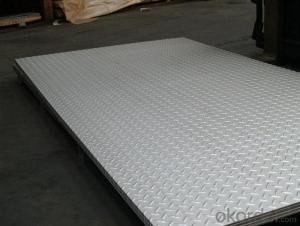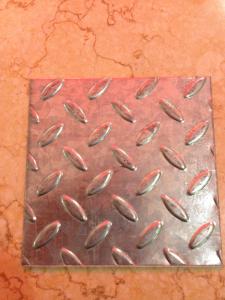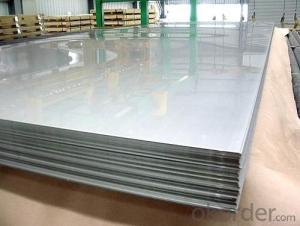stainless steel plate and sheet 202 cold rolled
- Loading Port:
- Tianjin
- Payment Terms:
- TT OR LC
- Min Order Qty:
- -
- Supply Capability:
- 5000 m.t./month
OKorder Service Pledge
Quality Product, Order Online Tracking, Timely Delivery
OKorder Financial Service
Credit Rating, Credit Services, Credit Purchasing
You Might Also Like
grade | 201,301,304,310,316,410,420,430,etc. |
surface | 2B,NO.1, NO.4, Mirror, Hairline, etc. |
thickness | 1MM, |
width | 1200MM,1220MM,1500MM,ETC. |
length | 2400MM,2440MM,3000MM,ETC. |
Payment terms | T/T, or L/C. |
Delivery time | Normally within 1 weeks after get your deposits. |
package | Standard export package, normally with wooden pallets |
MOQ | 5 tons/each size |
- Q: How do you prevent discoloration on stainless steel sheets?
- To prevent discoloration on stainless steel sheets, it is essential to avoid exposure to corrosive substances, such as salt, bleach, and strong acids. Regular cleaning with mild soap and water, followed by thorough drying, can help maintain the stainless steel's appearance. Additionally, applying a protective coating or using specialized cleaning products made for stainless steel can provide an extra layer of defense against discoloration.
- Q: Can stainless steel sheets be bent?
- Yes, stainless steel sheets can be bent. Stainless steel is a versatile material that can be easily formed into various shapes and configurations, including bends. The ability to bend stainless steel sheets is dependent on the thickness and composition of the material. Thinner sheets are generally more flexible and easier to bend, while thicker sheets may require specialized equipment and techniques. It is important to note that the bending process may cause the stainless steel sheet to lose some of its strength and durability, so careful consideration should be given to the specific application and requirements before attempting to bend stainless steel sheets.
- Q: How do you calculate the cost of a stainless steel sheet?
- To calculate the cost of a stainless steel sheet, you would typically consider factors such as the dimensions, thickness, grade of stainless steel, and market prices. By multiplying the area of the sheet with the cost per square unit, you can determine the total cost. It is important to consider additional expenses like shipping, handling, and any applicable taxes or fees.
- Q: What specifications do stainless steel plates have?
- General door with 304 doors or rust does not look good they will call you to change at a loss if you can go ah edge thickness wall door frame to plate factory they can count you can also tell them such as simple frame or Rome head of the door is generally
- Q: Can stainless steel sheets be used for conveyor belts?
- Yes, stainless steel sheets can be effectively used for conveyor belts. Stainless steel is known for its durability, strength, and resistance to corrosion, making it an ideal material for conveyor belts in various industries such as food processing, pharmaceuticals, and automotive. Its smooth surface also allows for easy cleaning and maintenance, ensuring hygiene and efficiency in conveyor operations.
- Q: Can stainless steel sheets be used for medical implants?
- Yes, stainless steel sheets can be used for medical implants. Stainless steel is a commonly used material in the medical field due to its excellent corrosion resistance, strength, and affordability. It is biocompatible, meaning it does not cause any adverse reactions when in contact with bodily tissues or fluids. Stainless steel sheets can be manufactured into various shapes and sizes to meet the specific requirements of medical implants, such as orthopedic plates, bone screws, dental implants, and cardiovascular stents. Additionally, stainless steel is easy to clean and sterilize, making it suitable for implantation in the human body. However, it is worth noting that different grades of stainless steel may have varying properties, so it is essential to select the appropriate grade based on the specific application and requirements of the medical implant.
- Q: What are the different types of stainless steel sheet edges available?
- There are several types of stainless steel sheet edges available, including mill edge, slit edge, deburred edge, rounded edge, and beveled edge. Each type has its own unique characteristics and is used for specific applications.
- Q: Are stainless steel sheets suitable for pharmaceutical equipment?
- Yes, stainless steel sheets are highly suitable for pharmaceutical equipment due to their excellent corrosion resistance, hygienic properties, and ease of cleaning. Stainless steel is non-reactive, non-toxic, and can withstand high temperatures, making it ideal for pharmaceutical applications that require strict cleanliness and durability.
- Q: Can stainless steel sheets be used in medical equipment?
- Medical equipment can indeed make use of stainless steel sheets. Due to its exceptional properties like resistance to corrosion, durability, and ease of cleaning, stainless steel is a favored option for medical devices and equipment. It is frequently employed in surgical instruments, implants, hospital equipment, and laboratory tools. The versatility of stainless steel sheets makes them a common choice in the manufacturing of medical equipment as they can be shaped into various forms and sizes. Furthermore, stainless steel is highly biocompatible, meaning it poses no harm to bodily tissues and can be safely used in medical applications. All in all, stainless steel sheets are a dependable and widely accepted material for medical equipment, offering both hygienic qualities and long-lasting performance.
- Q: Can stainless steel sheets be used for heat shields?
- Certainly! Heat shields can indeed utilize stainless steel sheets. Renowned for their exceptional heat resistance and durability, stainless steel proves to be an outstanding option for safeguarding against heat transfer. By effectively deflecting radiant, convective, and conductive heat, stainless steel sheets are well-suited for an array of purposes, encompassing automotive heat shields, industrial machinery, and household appliances. Moreover, their corrosion resistance and effortless maintenance render stainless steel sheets a pragmatic and enduring selection for heat shield implementations.
Send your message to us
stainless steel plate and sheet 202 cold rolled
- Loading Port:
- Tianjin
- Payment Terms:
- TT OR LC
- Min Order Qty:
- -
- Supply Capability:
- 5000 m.t./month
OKorder Service Pledge
Quality Product, Order Online Tracking, Timely Delivery
OKorder Financial Service
Credit Rating, Credit Services, Credit Purchasing
Similar products
Hot products
Hot Searches
Related keywords























